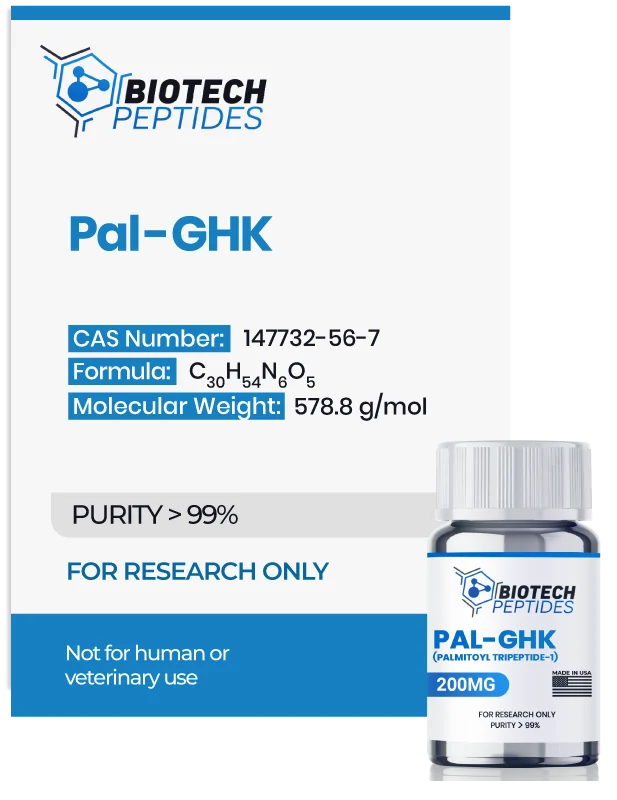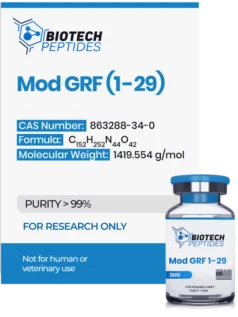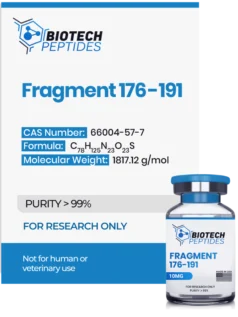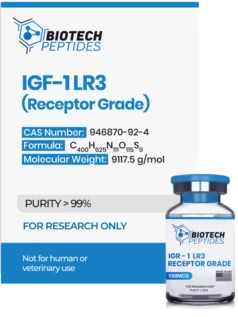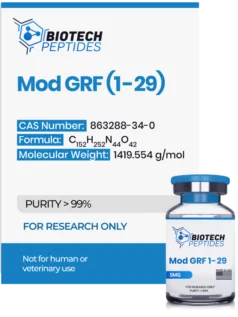Pal-GHK (Palmitoyl Tripeptide-1) (200mg)
$199.00
Pal-GHK (Palmitoyl Tripeptide-1) peptides are Synthesized and Lyophilized in the USA.
Discount per Quantity
| Quantity | 5 - 9 | 10 + |
|---|---|---|
| Discount | 5% | 10% |
| Price | $189.05 | $179.10 |
FREE - USPS priority shipping
Pal-GHK (Palmitoyl Tripeptide-1) Peptide
Pal-GHK, also known as Palmitoyl Tripeptide-1 and Palmitoyl Oligopeptide, is a synthetic peptide developed to function in protein production to support the skin’s extracellular matrix (ECM), and skin pigmentation. Pal-GHK is a synthetic hybrid peptide with one fatty acid and one peptide. “Pal” represents Palmitoyl—the covalent attachment of fatty acid to the end of the structure. “GHK” represents glycine-histidine-lysine—the peptide’s amino acid structure. This sequence is thought to be a small fraction of the large protein collagen, which is one of the main proteins in the extracellular matrix of skin and other tissues. The GHK sequence appears to be present in the “alpha 2(I) chain of type I collagen”, and researchers suggest that such a “tripeptide might be liberated by proteases at the site of a wound” as a signal of injury and thus, may be a powerful stimulant for repair.[1] Particularly, it may signal and attract fibroblasts—cells responsible for synthesizing collagen, elastin, and other proteins in the skin’s extracellular matrix, bones, and connective tissues. “Pal” represents Palmitoyl—the covalent attachment of fatty acid to the end of the structure. The addition of palmitoyl to the molecule is thought to result in better penetration through skin cells and, more specifically, stratum corneum.[2]
Specifications
Sequence: Palmitoyl-Gly-His-Lys
Molecular Formula: C30H54N6O5
Molecular Weight: 578.8 g/mol
Synonyms: Palmitoyl Tripeptide-1, Palmitoyl Oligopeptide
Pal-GHK Research
Pal-GHK Antioxidative Potential
The research suggests that there is “biological data demonstrating positive effects of GHK in skin and proposes interaction with antioxidant-related genes as a possible explanation of its antioxidant activity.”[3] The antioxidative potential of the GHK sequence in Pal-GHK may have protective actions for skin cells and lower their risk of experiencing faster aging due to active radicals and oxidative stress-causing factors like UV radiation. Examples of active radicals that may mediate the oxidative stress of UV exposure to skin cells may include reactive oxygen species (ROS), reactive nitrogen species (RNS), and reactive carbonyl species (RCS). Studies suggest that Pal-GHK may potentially possess anti-RCS properties, particularly against radicals like acrolein, malondialdehyde, and 4-hydroxynoneal, and thus reduce the risk of protein glycation of skin cell structures and ECM structures.[4]
Pal-GHK and Skin Thickness
As mentioned, Pal-GHK may function as a messenger for collagen renewal and may stimulate the synthesis of collagen and glycosaminoglycans, possibly reinforcing the epidermis. Some data suggests that Pal-GHK may influence transforming growth factor beta (TGFβ), a cytokine involved in cell growth and differentiation, to stimulate fibrillogenesis, which is the formation of collagen fibrils. This process may contribute to an increase in skin thickness. In a placebo-controlled setting, researchers observed what they described as a small yet statistically significant apparent increase in skin thickness of approximately 4% after Pal-GHK exposure compared to placebo.[5] Another 12-week clinical experiment also suggested that the amino acid sequence of the peptide may enhance collagen synthesis in dermal fibroblasts.[6] The researchers commented that the GHK sequence significantly improved collagen production and stimulated dermal keratinocyte proliferation. The research also confirmed an increase in skin thickness, improved skin hydration, and a significant smoothing of the skin by stimulating collagen synthesis, increased skin elasticity, and increased production of type 1 collagen. This was also confirmed via immunohistological assessments, which have indicated that GHK may have procollagen synthesis and, consequently, collagen synthesis in these cells.
Pal-GHK and Skin Appearance
Researchers suggest that the Pal-GHK peptide may be correlated with increased moisture retention as well.[7] When attached to short peptides, Pal-GHK appears to act cooperatively to reduce the prevalence of skin wrinkling and increase the moisture retention capacity of the skin cells. Pal-GHK has also been suggested to be influential in reducing redness and discolored skin following photodamage (melasma) in animal models.[8]
Pal-GHK and Skin Repair
Studies have explored the potential of the amino acid sequence GHK in enhancing skin tissue recovery in laboratory settings. The researchers reported that when Large plantar ulcers were exposed to the peptide, there was a pronounced enhancement of closure, and the incidence of ulcer infections was lower in the GHK group when compared to placebo. The scientists highlighted that the “incidence of ulcer infections was significantly lower (7% incidence compared with 34% for vehicle, p < 0.05) in the plantar ulcers.”[9] Another laboratory experiment on GHK suggested the peptide may cause a faster filling of the open wound to skin level with granulation tissue compared to controls.[10] Specifically, the time taken for the wounds to fill was reduced from 25 days in controls to 14 days in the GHK group. Additionally, the average time for complete healing was shorter in the GHK group (approximately 29.8 days) compared to controls (34.6 days).
Histopathological evaluations suggested that GHK might lead to a decrease in neutrophil counts and an increase in neovascularization within the wound area. This could imply that GHK promotes a more favorable inflammatory response and enhances the formation of new blood vessels, which are critical components of the wound healing process. Further research on GHK and skin wound closure in ischemic conditions suggested that over a period of 13 days, the peptide can lead to a notable decrease in wound area when compared to control or empty vehicle groups.[11] By day 13, the initial wound area had decreased by approximately 64.5% in the GHK group, whereas reductions were about 45.6% in the vehicle group and 28.2% in the control group. Additionally, biopsies taken on days 6, 10, and 13 revealed that wounds exposed to GHK-Cu contained lower concentrations of pro-inflammatory markers such as TNF-alpha, MMP-2, and MMP-9.
Disclaimer: The products mentioned are not intended for human or animal consumption. Research chemicals are intended solely for laboratory experimentation and/or in-vitro testing. Bodily introduction of any sort is strictly prohibited by law. All purchases are limited to licensed researchers and/or qualified professionals. All information shared in this article is for educational purposes only.
References
- Maquart, F. X., Pickart, L., Laurent, M., Gillery, P., Monboisse, J. C., & Borel, J. P. (1988). Stimulation of collagen synthesis in fibroblast cultures by the tripeptide-copper complex glycyl-L-histidyl-L-lysine-Cu2+. FEBS letters, 238(2), 343–346. https://doi.org/10.1016/0014-5793(88)80509-x
- Gorouhi F, Maibach HI. Role of topical peptides in preventing or treating aged skin. Int J Cosmet Sci. 2009 Oct;31(5):327-45. doi: 10.1111/j.1468-2494.2009.00490.x. Epub 2009 Jun 30. PMID: 19570099.
- Pickart, L., Vasquez-Soltero, J. M. & Margolina, A. GHK-Cu may Prevent Oxidative Stress in Skin by Regulating Copper and Modifying Expression of Numerous Antioxidant Genes. Cosmetics 2, 236–247 (2015).
- Cebrián J, Messeguer A, Facino RM, García Antón JM. New anti-RNS and -RCS products for cosmetic treatment. Int J Cosmet Sci. 2005 Oct;27(5):271-8. doi: 10.1111/j.1467-2494.2005.00279.x. PMID: 18492208.
- Lintner K, Peschard O. Biologically active peptides: from a laboratory bench curiosity to a functional skin care product. Int J Cosmet Sci. 2000 Jun;22(3):207-18. doi: 10.1046/j.1467-2494.2000.00010.x. PMID: 18503476.
- Abdulghani, A. A., Sherr, A., Shirin, S., Solodkina, G., Tapia, E. M., Wolf, B., & Gottlieb, A. B. (1998). Effects of topical creams containing vitamin C, a copper-binding peptide cream and melatonin compared with tretinoin on the ultrastructure of normal skin-A pilot clinical, histologic, and ultrastructural study. Disease Management and Clinical Outcomes, 4(1), 136-141.
- Trookman, N. S., Rizer, R. L., Ford, R., Mehta, R. & Gotz, V. Clinical assessment of a combination lip treatment to restore moisturization and fullness. J. Clin. Aesthetic Dermatol. 2, 44–48 (2009).
- Dupont, E. et al. Clinical efficacy of a serum integrating multiple cosmetic ingredients in the management of erythema of the face in aging skin. J. Cosmet. Dermatol. 11, 207–212 (2012)., Bradley, E. J., Griffiths, C. E. M., Sherratt, M. J., Bell, M. & Watson, R. E. B. Over-the-counter anti-ageing agents and their ability to protect and repair photoaged skin. Maturitas 80, 265–272 (2015). DOI: 10.1016/j.maturitas.2014.12.019
- Mulder GD, Patt LM, Sanders L, Rosenstock J, Altman MI, Hanley ME, Duncan GW. Enhanced healing of ulcers in patients with diabetes by topical treatment with glycyl-l-histidyl-l-lysine copper. Wound Repair Regen. 1994 Oct;2(4):259-69. doi: 10.1046/j.1524-475X.1994.20406.x. PMID: 17147644.
- Gul NY, Topal A, Cangul IT, Yanik K. The effects of topical tripeptide copper complex and helium-neon laser on wound healing in rabbits. Vet Dermatol. 2008 Feb;19(1):7-14. doi: 10.1111/j.1365-3164.2007.00647.x. PMID: 18177285.
- Canapp SO Jr, Farese JP, Schultz GS, Gowda S, Ishak AM, Swaim SF, Vangilder J, Lee-Ambrose L, Martin FG. The effect of topical tripeptide-copper complex on healing of ischemic open wounds. Vet Surg. 2003 Nov-Dec;32(6):515-23. doi: 10.1111/j.1532-950x.2003.00515.x. PMID: 14648529.

